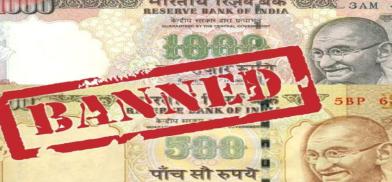Who gained from India's ill-conceived demonetisation policy?
The net impact of the overall Rs.32.12 lakh crore currency in circulation at present is that the benefit of demonetisation stands undone, resulting in a disturbing level of growth of a parallel economy and corruption in the country.

In November 2016, Indian Prime Minister Narendra Modi sprang a surprise on the country by announcing demonetisation of high-value currency notes in a nationwide address and also explained why demonetisation was necessary.
Modi said that considering the urgent need to wipe out black money circulating in the country, root out corruption and eliminate counterfeit notes, he had taken this measure. While stating that demonetisation was one of the measures that he would initiate to achieve the objectives, Modi also implied that curbing currency in circulation was a pre-condition to achieving such objectives.
The demonetisation announcement was followed by long queues in front of the banks, causing hardships to people in several ways.
Of course, admirers of Modi appreciated his courage of conviction to take a such bold decision, and sworn critics of Modi opposed his move bitterly. However, the fact is that by and large common people in India viewed Modi’s move as necessary and appropriate, which became clearly evident when Modi’s party, the BJP, was voted back to power with a clear majority in the subsequent election to parliament. The consensus view was that the demonetisation measure put huge fear in the mind of the corrupt people and black money holders and a huge quantity of unaccounted money were brought to light, which justified the demonetisation measure.
Huge increase in currency circulation
One of the claims made at the time of demonetisation by the Modi government was that the currency in circulation would be significantly brought down and digitalization would be promoted in a big way.
While the currency in circulation was significantly brought down immediately after demonetisation, the present ground reality is that the currency in circulation has now increased by over around 83 per cent after the demonetisation period in 2016.
Soon after demonetisation, the currency in circulation fell to a low of about ₹9 lakh crore on January 6, 2017, nearly 50 per cent of ₹17.74 lakh crore on November 4, 2016.
The currency in value terms has soared from ₹17.74 lakh crore on November 4, 2016, to ₹32.42 lakh crore on December 23, 2022. Currency in circulation, which was ₹18.04-lakh crore in end-March 2018, jumped to ₹31.34-lakh crore in end-March 2022 and further to ₹32.42-lakh crore as on December 23, 2022.
Have the benefits been achieved?
The question now is as to whether India has reaped the benefits of demonetisation measures subsequently. It appears that this has not happened.
Due to such a high currency circulation level at present, the use of unaccounted money ( mainly cash) has now soared. Recently, record seizures amounting to Rs.6.6 crore in cash were made in one single assembly constituency in Telangana. Almost every day, news Is appearing in the media that Enforcement Directorate and Income Tax authorities have been conducting raids and seizing huge amounts of cash from black-money holders. Some people think that the seizure of such black money is only the tip of the iceberg.
With such large currency circulation, the parallel economy is now in full flow in the country, accompanied by corruption in government departments and business dealings. Real estate deals are now increasingly being done by cash transactions using unaccounted cash.
The country seems to be back to square one, with a parallel economy increasing at an alarming level.
Better fiscal management needed
The government has not so far provided any credible explanation for increasing the currency in circulation multifold, which is much against the objective pronounced by Prime Minister Modi at the time of announcing demonetisation.
Some economists justify such huge cash in circulation by stating that it is necessary as the national economy is growing at a very impressive rate and people and business houses need cash to meet their requirements. Another argument that is advanced in favor of an increase in currency circulation is that so long as people pay tax properly directly or indirectly, the total amount of cash in circulation is not a matter of concern. To support this view, it is pointed out that the GST ( Goods and Services Tax) collection has been increasing steadily. Further, it is argued that even as cash in circulation is increasing multi-fold, digital transaction has also been increasing significantly.
There appears to be some fundamental flaw in the above argument and there should be a better way of fiscal management than printing currency notes in a developing country like India.
In the last few years, the government has been spending huge money by way of subsidy support, extending cash benefits to the farmers and welfare measures, and distributing free vaccines, particularly to reduce the sufferings of the people during the COVID period.
With the significant increase in currency circulation by the Reserve Bank of India, the Government of India collects money from the people in a variety of ways by issuing bonds, etc. and several state governments also do so.
Benefits undone
This strategy of the Modi government amounts to finding a short-term remedy for a long-term problem, which is bound to be counterproductive in the long run.
The net impact of the overall Rs.32.12 lakh crore currency in circulation at present is that the benefit of demonetisation stands undone, resulting in a disturbing level of growth of a parallel economy and corruption in the country.
It is necessary to note that the increase in tax collection by the government is nowhere in proportion to the huge increase in cash circulation in the country.
The increase in currency circulation has resulted in a steep increase in the price of goods and services, creating a huge burden on the family budget of those living in the lower and middle-income groups, pensioners and those belonging to unorganised classes in the country.
(The writer is a Trustee, of NGO Nandini Voice for the Deprived, Chennai and a policy commentator. Views are personal. He can be reached at nsvenkatchennai@gmail.com)




















Post a Comment